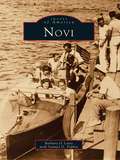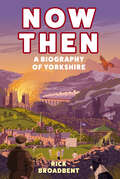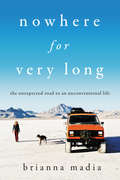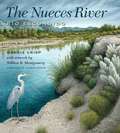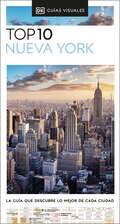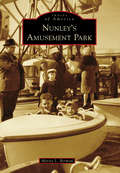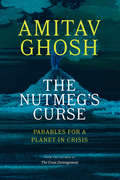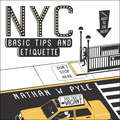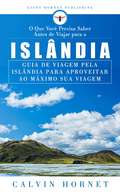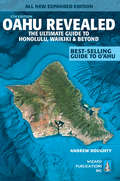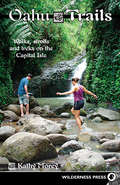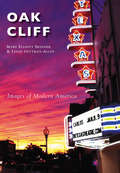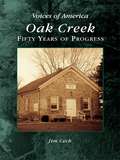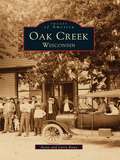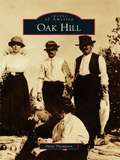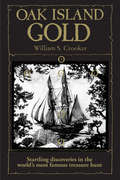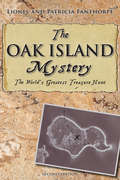- Table View
- List View
Novi (Images of America)
by Barbara G. Louie Samuel D. PopkinFrom a peaceful farming community to a thrivingcommercial suburb, Novi, Michigan, has undergone manyperiods of dramatic change, creating the rich history that is explored in this volume. This collection of over 200 photographs provides afascinating record of the development of Novi throughthe 19th and 20th centuries. In the early days of westward exploration, the fertile land surrounding Detroit attracted the first settlers of Novi. The town grew quickly after the 1825 opening of the Erie Canal, and by 1830, a bustling business district had emerged. The major changes came in the 1950s, with the building of freeways that cut directly throughthe heart of Novi. The sudden easy access to Detroit and Lansing ensured the town's future as a true American suburb. Shopping centers soon followed in the tire tracks of the freeway, and the area rapidly expanded.
Now Then: A Biography of Yorkshire
by Rick BroadbentNow Then is a biographical mosaic of Yorkshire. Rick Broadbent, an award-wining author and exiled Yorkshireman, goes in search of the soul of England's biggest county and produces an all-encompassing portrait of a place that has been victimised and stereotyped since the days of Williams the Conqueror. Incorporating social history, memoir, reportage and author interviews, Now Then paints a picture of what it means to be from Yorkshire - both now and back then.Now Then is not a hagiography and Broadbent visits devastated mining communities, an inner-city homeless shelter and the county's most isolated sheep farm, as well as examining the truth about well-known Yorkshire figures and institutions. From the Bronte sisters and Marks & Spencer to the Yorkshire pudding, accent and Ripper, this is a funny, wise and searching account of the county that gave the world its first football club and its last witch-burning. Ultimately, this is an affectionate but unsparing look at a county, its people and their flinty vowels. It is about the real Yorkshire and its daily life, as well as Dracula and Geoffrey Boycott.
Nowhere for Very Long: The Unexpected Road to an Unconventional Life
by Brianna MadiaIn this beautifully written, vividly detailed memoir, a young woman chronicles her adventures traveling across the deserts of the American West in an orange van named Bertha and reflects on an unconventional approach to life. <p><p>A woman defined by motion, Brianna Madia bought a beat-up bright orange van, filled it with her two dogs Bucket and Dagwood, and headed into the canyons of Utah with her husband. Nowhere for Very Long is her deeply felt, immaculately told story of exploration—of the world outside and the spirit within. <p><p>However, pursuing a life of intention isn’t always what it seems. In fact, at times it was downright boring, exhausting, and even desperate—when Bertha overheated and she was forced to pull over on a lonely stretch of South Dakota highway; when the weather was bitterly cold and her water jugs froze beneath her as she slept in the parking lot of her office; when she worried about money, her marriage, and the looming question mark of her future. But Brianna was committed to living a life true to herself, come what may, and that made all the difference. <p><p>Nowhere for Very Long is the true story of a woman learning and unlearning, from backroads to breakdowns, from married to solo, and finally, from lost to found to lost again . . . this time, on purpose. <p> <b>New York Times Bestseller</b>
The Nueces River: Río Escondido (River Books)
by Margie CrispFirst appearing on early Spanish maps as the Río Escondido, or hidden river, and later named Río de las Nueces after the abundant pecan trees along its banks, the Nueces today is a stream of seeming contradictions: a river that runs above and below ground; a geographic reminder of a history both noble and egregious; and a spring-fed stream transformed into a salty, steep-sided channel. <P><P>From its fresh, clear headwaters on the Edwards Plateau, Margie Crisp and William B. Montgomery follow the river through the mesquite and prickly pear of the South Texas Plains, to the river’s end in Nueces and Corpus Christi Bays on the Gulf of Mexico. With vivid prose and paintings, they record their travels as they explore the length of the river on foot, kayak, and fishing boat, ultimately weaving a vivid portrait of today’s Nueces. Capturing the river’s subtle beauty, abundant wildlife, diverse culture, and unique history of exploration, conflict, and settlement, they reveal the untold story of this enigmatic river with passion, humor, and reverence.
Nueva York Guía Top 10 (Pocket Travel Guide)
by DK EyewitnessTop 10 Nueva York Es la mejor guía en el mercado, tamaño bolsillo, con ideas y consejos de los locales, incluye mapas a todo color, listas top 10, mapa que puedes llevar contigo - todo diseñado para que tengas una experiencia para recordar.Disfrutarás esta guía porque..El contenido y el diseño es claro y fácil de usarLos destinos están totalmente actualizados, con consejos de expertos de esta región.Incluye las listas top 10 accesibles y variadas, que te llevan a los monumentos icónicos y edificios más representativos y paseos por las zonas más populares y visitas imprescindiblesTiene mapas, planos y descripciones detalladas de todos los puntos clave del destinoRecomendaciones sobre los mejores hoteles, restaurantes, tiendas y locales de ocioNueva York es una ciudad única: rebosante de monumentos y famosa por los museos, los teatros y la animada vida nocturna. Visita la Estatua de la Libertad, pasea por Central Park y sube al Empire State Building. ¡Bienvenidos a Nueva York!Your journey starts here. Featuring DK&’s much-loved maps and illustrations, walks and information, plus all new, full-color photography, our 100% updated guides bring you the best a destination has to offer in a lightweight format.Top 10 Nueva York is an unbeatable, pocket-sized guide, packed with insider tips and ideas, color maps, top 10 lists, and a laminated pull-out map – all designed to help you experience the very best of a destinationYou will enjoy this guide because..Contemporary jacket designUpdated regularly, by experts with an in-depth knowledge of the region Includes Top 10 lists that are accessible and varied – leading you straight to the best places to visit, both famous and off the beaten trackThe guide includes a laminated pull-out map, with a selected street and sight indexRecommended hotels, restaurants, shops and places of leisure.
The Number: Why Companies Lied And The Stock Market Crashed
by Alex BerensonWith a new Afterword by the author and a new Foreword by Mark Cuban In this commanding big-picture analysis of what went wrong in corporate America, Alex Berenson, a top financial investigative reporter for The New York Times, examines the common thread connecting Enron, Worldcom, Halliburton, Computer Associates, Tyco, and other recent corporate scandals: the cult of the number. Every three months, 14,000 publicly traded companies report sales and profits to their shareholders. Nothing is more important in these quarterly announcements than earnings per share, the lodestar that investors--and these days, that's most of us--use to judge the health of corporate America. earnings per share is the number for which all other numbers are sacrificed. It is the distilled truth of a company's health. Too bad it's often a lie. Alex Berenson's The Number provides a comprehensive, brutally factual overview of how Wall Street and corporate America lost their way during the great bull market that began in 1982. With wit and a broad historical perspective, Berenson puts recent corporate accounting (or accountability) disasters in their proper context. He explains how the wheels came off the wagon, giving readers the information and analysis they need to understand Enron, Tyco, WorldCom, Halliburton, and the rest of the corporate calamities of our times.
Nunley's Amusement Park
by Marisa L. BermanNunley's Amusement Park in Baldwin, New York, was a beloved family destination for Long Islanders from 1939 until it closed in 1995. The park's most notable attraction was its famed Stein & Goldstein carousel. The Nunley family established numerous amusement parks in the Long Island area, such as those found in Bethpage, Rockaway Beach, and Broad Channel. Nunley's Amusement Park, which was in operation for over 50 years, has a special place in the memories of multiple generations of Long Islanders. After the park closed, the rides and games were sold at auction. In protest, Long Islanders banded together to prevent the carousel from being disassembled and sold off separately. Recognizing the passion residents held for the park, Nassau County stepped in and purchased the beloved carousel, and an elaborate campaign was established for its restoration. The year 2012 marked the 100th anniversary of the famous Nunley's Carousel, which is currently in operation at Museum Row in Garden City, New York.
The Nutmeg's Curse: Parables for a Planet in Crisis
by Amitav GhoshThe author of The Great Derangement finds the origins of our climate crisis in Western colonialism&’s violent exploitation of human life and the environment. A powerful work of history, essay, testimony, and polemic, Amitav Ghosh&’s new book traces our contemporary planetary crisis back to the discovery of the New World and the sea route to the Indian Ocean. The Nutmeg&’s Curse argues that the dynamics of climate change today are rooted in a centuries-old geopolitical order constructed by Western colonialism. At the center of Ghosh&’s narrative is the now-ubiquitous spice nutmeg. The history of the nutmeg is one of conquest and exploitation—of both human life and the natural environment. In Ghosh&’s hands, the story of the nutmeg becomes a parable for our environmental crisis, revealing the ways human history has always been entangled with earthly materials such as spices, tea, sugarcane, opium, and fossil fuels. Our crisis, he shows, is ultimately the result of a mechanistic view of the earth, where nature exists only as a resource for humans to use for our own ends, rather than a force of its own, full of agency and meaning. Writing against the backdrop of the global pandemic and the Black Lives Matter protests, Ghosh frames these historical stories in a way that connects our shared colonial histories with the deep inequality we see around us today. By interweaving discussions on everything from the global history of the oil trade to the migrant crisis and the animist spirituality of Indigenous communities around the world, The Nutmeg&’s Curse offers a sharp critique of Western society and speaks to the profoundly remarkable ways in which human history is shaped by non-human forces.
NY DOGS
by Violet Lemay Jorge BenderskyNew York is the City of Dreams, and NY DOGS is a celebration of the Big Apple’s furriest, friendliest, funniest sidewalk stompers. . .and the humans who pick up their poo. Written and illustrated by Violet Lemay (New York Baby, 100 Pablo Picassos), this stylish book offers a humorous window to the uniqueness of dogs living in America’s largest city.With an Introduction by Jorge Bendersky, author of DIY Dog Grooming, From Puppy Cuts to Best in Show.
NYC Basic Tips and Etiquette
by Nathan W. PyleLiving in New York City for five years as a transplant from Ohio, illustrator and T-shirt designer Nathan Pyle was fascinated by the unique habits and unspoken customs New Yorkers follow to make life bearable in a city with 8 million people (and seemingly twice the number of tourists). <P><P>In NYC Basic Tips and Etiquette, Pyle reveals the secrets and unwritten rules for living in and visiting New York including the answers to such burning questions as, how do I hail a cab? What is a bodega? Which way is Uptown? Why are there so many doors in the sidewalk? How do I walk on an escalator? Do we need be touching right now? Where should I inhale or exhale while passing sidewalk garbage? How long should I honk my horn? If New York were a game show, how would I win? What happens when I stand in the bike lane? Who should get the empty subway seats? How do I stay safe during a trash tornado? Each tip is a little story illustrated in simple black and white drawings.
The Nyonya Kebaya
by Datin SeriThis longtime Malaysian fashion icon was originally a long, straight, Arab-inspired top of plain woven cotton. <P><P>The Nyonyas, the women of the early Peranakan community, gradually transformed it into a shapely, embroidered, translucent blouse, fastened with a set of chained brooches and worn with a matching hand-drawn batik sarong.Sheer, romantic, alluring, yet sedate, the designs of Nyonya kebaya crosses several generations and cultures.This book showcases the collection of Datin Seri Endon Mahmood, wife of the Prime Minister of Malaysia.
O amor não pede licença
by Aparecida Da Costa Lea RosenbaumNeste romance Lea Rosenbaum descreve com muito sensibilidadeum triângulo amoroso, triângulo este que só fica evidente muito aos poucos, no decorrer da trama: Sarah, seu grande amigo e confidente, Rob, e seu namorado, Markus. Sarah custa a entender que uma grande amizade pode mascarar um tímido amor e que o mais óbvio amor na verdade é apenas desejo de vivenciar um amor, o qual está em outro lugar, bem em baixo do nariz da gente, como se costuma dizer."
O Come Ye Back to Ireland: Our First Year In County Claire
by Niall Williams Christine BreenTwo years ago Niall Williams and his wife, Christine Breen, abandoned their urban careers and paychecks and their many comforts to return to the rugged, rural life of their ancestral Ireland. They emigrated back to the land of their forefathers. Answering a sentimental longing to reconnect to the place of their origin, they booked one-way tickets, pooled and budgeted savings, and bundled up their worldly possessions. Niall would write, Christine would paint, and they would soon grow produce and maintain live-stock. The town they settled near was the village of Kilmihil, 12 miles from the sea, on Ireland's western coast. The place is damp, gray and utterly beautiful. The house, her great grandfather's cottage is heated only by turf which Niall must learn to cut from the nearby bogs and burn in the open fireplace. There is no telephone, no chain saw. There are no restaurants, cinemas, subways, cities or sounds other than the wind, the rain and the jackdaws. Christine sets upon the overgrown garden, salvaging the flowers from among the weeds. The garden, she realizes, was first put in by her great grandfather 200 years earlier. Though the skies rain for an entire summer, she manages to paint and even teach aerobics to the local ladies, as she also strives to earn the welcome she finally receives as Jack O'the Grove's granddaughter.Niall learns to kill a chicken, rids the house of a hoard of bees, finds the burial grounds of a mythical giant and ultimately takes a course to learn to be a farmer. Together Niall and Christine brought the farmland of Kiltumper back to life and together they have written this journal, delightfully illustrated with Christine's art. Niall and Christine first met at University College in Dublin, the city where Niall was born and raised. Christine was born in New Jersey and raised in New York. She graduated from Boston College. They have stories and poems published in Ireland in the past 2 years. Before that Christine worked in New York City at a medical journal and Niall was a copywriter at a mass market publishing house, where he also penned a romance newsletter under the name of "Sarah Reynolds."
O Lado Negro da Disney
by Andrea Scauri Leonard KinseyO LADO NEGRO DA DISNEY revela todas as dicas, truques, golpes e histórias que ELES não querem que você saiba! Sem pudor e sem medo de ofender o público voltado para a família, atendido pelos outros guias de viagem da Disney, o autor Leonard Kinsey dá a viajantes intrépidos o acesso ao submundo sórdido, atrevido e muitas vezes hilário do Walt Disney World. Desde seus contos de advertência de como arranjar ingressos ilegais até histórias emocionantes de explorações em áreas proibidas e crônicas sobre depravações induzidas por drogas, este guia completamente não autorizado mudará a forma como você pensa em tirar férias no "Lugar Mais Feliz da Terra". "Faça as malas e deixe as crianças na casa da vovó, porque você terá as melhores férias na Disney da sua vida com O LADO NEGRO!" -Chris Mitchell, autor de CAST MEMBER CONFIDENTIAL
O Que Você Precisa Saber Antes de Viajar para a Islândia: Guia do viajante islandês para aproveitar ao máximo sua viagem
by Calvin HornetA Islândia é uma terra de extremos com icebergs flutuando perto de fontes termais, desolação e beleza exuberante, cores vibrantes pintadas em extensões vazias sem uma planta viva ou animal à vista. Você pode festejar até cansar uma noite e assistir a aurora boreal dançar sobre sua cabeça enquanto você tenta decidir se acredita que é o resultado de partículas do sol batendo na atmosfera da Terra, ou se são alienígenas dizendo “olá”. Apesar de sua localização remota, a Islândia ainda atrai mais de um milhão de visitantes todos os anos, três vezes a população do país. O poder magnético da Islândia para atrair turistas de suas casas para as suas margens é encontrado bem abaixo da superfície, onde a crosta terrestre está lentamente se separando ao longo da Cordilheira Mesoatlântica, a fonte de muitas montanhas e terremotos na Islândia. Embora haja muitos vulcões geologicamente ativos em geral, eles não estão expelindo lava continuamente, embora você possa experimentar a natureza explosiva da terra volátil durante sua visita, se houver uma erupção recente, ou você tiver a sorte de ficar preso na Islândia durante uma. O Que Encontrará Dentro: •Planejando sua viagem com antecedência •Geologia, natureza e história da Islândia •Sul e Oeste da Islândia •Norte e leste da Islândia •Dicas e truques •Palavras e frases islandesas comuns •E mais...
Oahu Revealed: The Ultimate Guide To Honolulu, Waikiki & Beyond
by Andrew Doughty Leona BoydThe finest guidebook ever written for O'ahu. Now you can plan your best vacation--ever. This all new expanded fifth edition is a candid, humorous guide to everything there is to see and do on the island. Written by the author of the best-selling guides, Maui Revealed, Hawaii The Big Island Revealed and The Ultimate Kauai Guidebook. Explore with him as he reveals breathtaking trails, secluded beaches, pristine reefs, delicious places to dine, relaxing places to stay, exciting waterfalls, colorful valleys and so much more. Every restaurant, activity provider, business and resort is reviewed personally and anonymously. This book and a rental car are all you need to discover what makes O'ahu so exciting.* The most up-to-date and accurate information available anyplace with up-to-the-minute changes posted to our website* Frank, brutally honest reviews of restaurants, hotels and activities show you which companies really are the best...and which to avoid--no advertisements* Driving tours let you structure your trip your way, point out sights not to be missed along the way and are complemented by over 150 spectacular color photographs* 21 specially-created maps in an easy-to-follow format with landmarks--so you'll always know where you are on the island* Clear, concise directions to those hard-to-find places such as deserted beaches, hidden waterfalls, lush rain forests, spectacular coastlines and scores of other hidden gems listed nowhere else* Exclusive chapter on O'ahu's beaches with detailed descriptions including ocean safety* Unique Adventures & Attractions chapter, over 60 pages of exciting activities from ATVs to whale watching, and over 200 restaurant reviews* Fascinating sections on Hawai'i's history, culture, language and legends* Companion website with links to every business, events calendar, over 80 resort reviews complete with aerial photos--so you'll know if oceanfront really means oceanfront Oahu Revealed covers it all--from the top of the Ko'olaus to the lost sunken island off Kane'ohe. This is the best investment you can make for your O'ahu vacation. Whether you are a first time visitor or a long time kama'aina, you will find out more about O'ahu from this book than from any other source. Discover the island of your dreams with Oahu Revealed.
Oahu Trails
by Kathy MoreyThis guide to 45 great hikes on Oahu includes 2 new trips in the inland rainforests of Kailua and Waimanalo. Explore the beaches, cliffs, and rainforests, and learn about native plants, Hawaiian history, and local mythology.
Oak and Ash and Thorn: The Ancient Woods and New Forests of Britain
by Peter FiennesA Guardian Best Nature Book of the Year The magic and mystery of the woods are embedded in culture, from ancient folklore to modern literature. They offer us refuge: a place to play, a place to think. They are the generous providers of timber and energy. They let us dream of other ways of living. Yet we now face a future where taking a walk in the woods is consigned to the tales we tell our children. Immersing himself in the beauty of woodland Britain, Peter Fiennes explores our long relationship with the woods and the sad and violent story of how so many have been lost. Just as we need them, our woods need us too. But who, if anyone, is looking out for them?
Oak Cliff (Images of Modern America)
by Mary Elliott Skinner Leigh Gettman-AllenThe community of Oak Cliff is one of progress and transformation, experiencing a "rebirth" over the last few decades. Covering approximately one fourth of Dallas County, Oak Cliff has become one of the most ethnically diverse and culturally opulent neighborhoods in the state of Texas. From the events surrounding the death of Pres. John F. Kennedy to the demographic shifts over the last 40 to 50 years, Oak Cliff has become a symbol of inimitability, re-establishing its image as one of the most desirable neighborhoods in the United States.
Oak Creek: Fifty Years of Progress
by Jim CechIn the early 1830s, U.S. officials forced the Menomonee and Potawatomi Indians to give up their lands in present-day Milwaukee County. Men from England and the eastern United States purchased large tracts of land along Lake Michigan from the government. Settlers like John Fowle, George Cobb, and Luther Rawson brought families to southeastern Wisconsin and helped establish the town of Oak Creek. For more than 100 years, Oak Creek retained its township status and rural character. But in 1955, Milwaukee city leaders attempted to annex Oak Creek's land and collect income tax revenue from a recently completed power plant. The small town won a legendary incorporation battle with their powerful northern neighbor, setting a precedent that also saved Franklin and Greenfield from being absorbed by Milwaukee.
Oak Creek, Wisconsin
by Larry Rowe Anita RoweOak Creek, Wisconsin, is a close-knit community with a long tradition of farming. Authors Anita and Larry Rowe have compiled this volume of photographs from the Oak Creek Historical Society, CNI newspapers, and many longtime residents to trace the history of Oak Creek from the turn of the century, when the community was mostly farmland, to its incorporation as a city in the 1950s. With this glimpse into Oak Creek's past, residents of all ages will delight in discovering the unique heritage of this city in southeastern Wisconsin. The images featured, many of which have never before been published, offer rare views into the daily lives of the area's early settlers at work and at play. Family histories, Oak Creek's struggle for an independent identity outside of the city of Milwaukee, the stories behind the historic buildings at the Oak Creek Historical Museum, and the colorful past of the city's taverns are all brought to life in Oak Creek, Wisconsin.
Oak Hill (Images of America)
by Dana Baldwin ThompsonBeginning with the Timucuan Indians around 2000 BC, life along the Indian River in Oak Hill has always been simple. The natural beauty and pristine environment that drew Oak Hill's first inhabitants to the area still abounds, and the waterfront lined with large oak trees continues to inspire a feeling of serenity and relaxation. The first Florida pioneers settled in Oak Hill around 1870 and were drawn by the treasures of a diverse ecosystem of marshland, cypress hammock, and timber pine forest. These first settlers harvested the natural resources of timber, turpentine, and salt, followed by citrus groves and a thriving fishing industry. The selected photographs in this book, many appearing courtesy of local families, document the lives and times of Floridians who chose to call Oak Hill home.
Oak Island Gold
by William S. Crooker&“Crooker, who is a good historian and also quite witty, tells a tale of folly and obsession&” surrounding the legendary treasure off of Canada&’s east coast (Booklist). For over two centuries, the mysterious labyrinth of shafts and tunnels under Oak Island, a tiny island on Nova Scotia&’s South Shore, has been the scene of a frantic search by scores of treasure hunters from two continents. They believe that the shafts and intricate man-made flooding system hold the secret to a treasure of untold wealth. Although millions have been spent, bitter feuds have erupted, and men have died, the treasure has remained as elusive as the answers to who built the labyrinth, why and how it was constructed, and the nature of the treasure itself. Until now. In his second book on the Oak Island mystery, William Crooker meticulously sifts through the evidence unearthed by treasure hunters on the island, past and present. Then, armed with some starling new discoveries, he neatly fits the pieces together to offer a plausible solution to the baffling puzzle of Oak Island.&“Crooker, an engineer and surveyor, presents both a thorough historical review of the various digs and a look at all the theories about the treasure.&” —Library Journal
Oak Island Gold: Startling New Discoveries In The World's Most Famous Treasure Hunt
by William S. Crooker“Crooker, who is a good historian and also quite witty, tells a tale of folly and obsession” surrounding the legendary treasure off of Canada’s east coast (Booklist).For over two centuries, the mysterious labyrinth of shafts and tunnels under Oak Island, a tiny island on Nova Scotia’s South Shore, has been the scene of a frantic search by scores of treasure hunters from two continents. They believe that the shafts and intricate man-made flooding system hold the secret to a treasure of untold wealth. Although millions have been spent, bitter feuds have erupted, and men have died, the treasure has remained as elusive as the answers to who built the labyrinth, why and how it was constructed, and the nature of the treasure itself. Until now. In his second book on the Oak Island mystery, William Crooker meticulously sifts through the evidence unearthed by treasure hunters on the island, past and present. Then, armed with some starling new discoveries, he neatly fits the pieces together to offer a plausible solution to the baffling puzzle of Oak Island.“Crooker, an engineer and surveyor, presents both a thorough historical review of the various digs and a look at all the theories about the treasure.” —Library Journal
The Oak Island Mystery: The Secret of the World's Greatest Treasure Hunt
by Lionel Fanthorpe Patricia FanthorpeThe Oak Island mystery has been the world’s greatest and strangest treasure hunt, and after years of research the authors have finally solved the sinister with an answer that is challenging, controversial, and disturbing. In 1795 three boys discovered the top of an ancient shaft on uninhabited Oak Island in Mahone Bay, Nova Scotia. The boys began to dig, and what they uncovered started the world’s greatest and strangest treasure hunt but nobody knows what the treasure is. Two hundred years of courage, back-breaking effort, ingenuity, and engineering skills have failed to retrieve what is concealed there. Theories of what the treasure could be include Captain Kidd’s bloodstained pirate gold, an army payroll left by the French or British military engineers, priceless ancient manuscripts, the body of an Arif or other religious refugee leader, or the lost treasure of the Templars. The Oak Island curse prophesies that the treasure will not be found until seven men are dead and the last oak has fallen. That last oak has already gone, and six treasure hunters have been killed. After years of research, the authors have finally solved the sinister riddle of Oak Island, but their answer is challenging, controversial, and disturbing. Something beyond price still lies waiting in the labyrinth.
